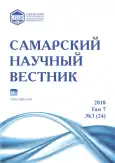Using mobile technologies for studying foreign languages
- Authors: Drygina M.V.1
-
Affiliations:
- Immanuel Kant Baltic Federal University
- Issue: Vol 7, No 3 (2018)
- Pages: 317-321
- Section: 13.00.00 – Pedagogical Sciences
- URL: https://journals.rcsi.science/2309-4370/article/view/21755
- DOI: https://doi.org/10.17816/snv201873305
- ID: 21755
Cite item
Full Text
Abstract
In our modern world mobile devices play an important role in the learning process and provide more opportunities for access to educational resources. The use of mobile devices in the learning process is a promising direction that attracts researchers all over the world. Although mobile devices are widely used and they are accessible means of studying, they are still not perceived as means of foreign language learning. The use of mobile technologies will make it possible not only to induce the learning process visibility, divisiveness and interaction, but also to improve the quality of education, and to expand the possibilities for both students and teachers. The paper presents a systematic review of resources on the problem of mobile assisted language learning. The results of the research have shown that this method is widely used by researchers in Scandinavian countries. The classification has been made on the basis of the existing concept of mobile learning. In addition, the paper describes main technical, pedagogical and psychosocial factors which influence the development of modern resources for mobile learning of foreign languages.
Full Text
##article.viewOnOriginalSite##About the authors
Mariia Viktorovna Drygina
Immanuel Kant Baltic Federal University
Author for correspondence.
Email: mariadrygina@list.ru
postgraduate student of Education Institute
Russian Federation, KaliningradReferences
- Андреев А.А., Солдаткин В.И. Прикладная философия открытого образования: педагогический аспект. М.: РИЦ «Альфа» МГОПУ им. М.А. Шолохова, 2002. 168 с.
- Бескровный И. Номо Mobiles: шаг в сторону матрицы // E-Learning World. 2004. № 4. С. 25-31.
- Куклев В.А. Опыт разработки электронных образовательных ресурсов: от компьютеризированных учебников через сетевые технологии к мобильному образованию // Информатика и образование. 2006. № 2. С. 103-106.
- Баннистер Б. Реальный масштаб времени - это текущий момент // Мобильные системы. 2006. № 2. С. 3-12.
- Kukulska-Hulme A. Will mobile learning change language learning? // ReCALL. 2009. № 21 (2). P. 157-165.
- Yamada M., Goda Y. Application of Social Presence Principles to CSCL Design for Quality Interactions / Ed. Jiyou Jia // Educational Stages and Interactive Learning: From Kindergarten to Workplace Training, IGI Global. 2012. P. 31-48.
- Yannick J. M-Learning: A pedagogical and technological model for language learning on mobile phones // Blended Learning / eds. J. Fong, F.L. Wang. 2007. P. 327-339.
- Chen N.S.S.-W., Hsieh K. Effects of short-term memory and content representation type on mobile language learning // Language Learning & Technology. 2008. № 12 (3). P. 93-113.
- Kim D.J., Ferrin D.L., Rao H.R. Trust and satisfaction, two stepping stones for successful E-Commerce relationships: A longitudinal exploration // Information Systems Research. 2009. Vol. 20 (2). P. 237-257.
- Chen C.M., Hsu S.-H. Personalized Intelligent Mobile Learning System for Supporting Effective English Learning // Educational Technology & Societ. 2008. № 11 (3). P. 153-180.
- Liu P.L. Computer-assisted concept maps for English reading and summary writing. Crane: Taipei, 2010. P. 17-19.
- Liu P.L., Chen C.J., Chang Y.J. Effects of a computer-assisted concept mapping learning strategy on EFL college students’ English reading comprehension // Computers & Education. 2010. P. 436-445.
- Lu Y., Cao Y., Wang B., Yang S. A study on factors that affect users’ behavioral intention to transfer usage from the offline to the online channel // Computers in Human Behavior. 2011. № 27. P. 355-364.
- Petersen S.A., Divitini M., Chabert G. Sense of community among mobile language learners: Can blogs support this? // International Journal of Web Based Communities. 2009. № 5 (3). P. 428-445.
- Zhang H., Song W., Burston J. Reexamining the effectiveness of vocabulary learning via mobile phones // TOJEТ. 2010, № 10 (3). P. 203-214.
- Kern R. Perspectives on technology in learning and teaching languages // TESOL Quarterly. 2006. № 40 (1) P. 183-210.
- Lan Y.-J., Sung Y.-T., Chang K.-E. A mobile-device-supported peer-assisted learning system for collaborative early EFL reading // Language Learning & Technology. 2007. № 11 (3). P. 130-151.
- Churchill D. Educational applications of Web 2.0: Using blogs to support teaching and learning // British Journal of Educational Technology. 2010. № 40. P. 179-183.
- Masterman E., Manton M. Teachers’ perspectives on digital tools for pedagogic planning and design // Technology, Pedagogy and Education. 2009. № 20 (2). P. 227-246.
- Viberg O., Grönlund Å. Mobile Assisted Language Learning: A Literature Review // Proc. of the 11th Int. Conf. on Mobile and Contextual Learning. Vol. 955, Helsinki, Finland, 16-18 October, 2012. P. 9-16.
Supplementary files






